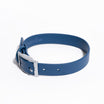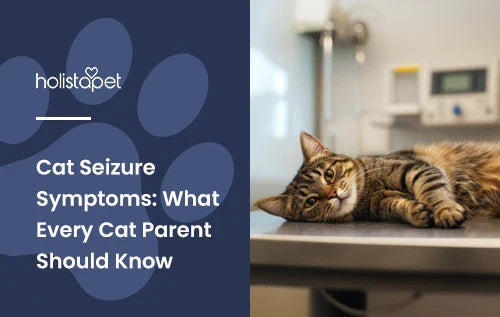Your kitty's ears speak louder than you think. A quick flick or a sudden flattening can spill the tea on their mood. So what does a cat's ear position mean exactly? Turns out, it means everything.
If you've ever caught those furry triangles in airplane mode or aimed straight at the window, chances are they're trying to tell you something. We advise you to tune in.
Why Do Cats Communicate With Their Ears?

Ear position plays a big role in cat communication since our feline friends don't use words to express themselves. The outer ear moves independently, picking up sounds and adjusting to changes in the environment. When a cat reacts to another animal, a sudden noise, or a hand reaching in, their ears usually move first. Owners who learn to read these cues can respond better and avoid unwanted reactions.
The Basics of Cat Ear Positions
A cat's ears are powerful tools for sensing and reacting. Each has over 30 muscles, giving them full control to swivel, tilt, and rotate. This lets felines pick up on the tiniest sounds and shift focus without moving their head.
Cats use different ear positions to show how they feel. Ears forward can mean a kitty is feeling curious or calm. Ears sideways or back might suggest nervousness or irritation. Recognizing these changes helps cat owners stay in tune with their pet's mood and comfort level.
Forward-Facing Ears

When your cat's ears point straight ahead, it's usually a sign that they're interested and aware of what's happening. You might observe this position when they're watching birds through the window or listening closely to a noise in the next room.
-
Alert and Curious. Ears straight forward often means your cat is fully locked in. They're paying close attention, possibly prepping to pounce or play. This is common during interactive time or when they're exploring new spaces.
-
Happy and Relaxed. Forward ears can also show a calm mood. If the rest of the body looks loose and the tail isn't twitching, your feline friend likely feels comfortable. It's a good time to engage and enjoy the moment together.
Sideways or "Airplane" Ears
When your cat's ears shift sideways like tiny wings, that's the classic "airplane" position. This usually signals mixed emotions or overstimulation. The ears flatten out slightly but don't press back completely.
-
Nervous or Unsure. Sideways ears can show uncertainty. Watch their body posture. Tense muscles or a lowered head often pair with this position.
-
Overstimulated From Petting. If you see your cat's ears shift sideways during a cuddle session, it might mean they've had enough. Pay attention to this subtle cue to avoid upsetting your feline companion.
Flattened Ears (Pinned Back)
When a cat pins their ears flat against their head, it's a strong signal that they feel threatened or upset. It often comes with other signs like a puffed-up tail and a low growl.
-
Fear or Stress. A scared cat flattens their ears to protect them. This usually happens during loud noises, vet visits, and tense interactions with other cats. It's a clear sign to give them space.
-
Aggression or Defensiveness. Flattened ears can also show that your pet is feeling cornered or defensive. If paired with hissing or swatting, they're trying to warn others to back off. It's best not to push their limits when this happens.
Backward-Turned Ears
When your cat's ears point backward, they're tuned into something behind them or feeling some kind of way. This position usually means they're attentive, irritated, or deeply focused. It's one of the more misunderstood ear signals.
-
Focused or Hunting. Cats often turn their ears back when tracking sounds from behind. If, along with this ear shift, your kitty crouches low and watches something closely, it means they're in full hunter mode.
-
Annoyed or Irritated. Ears turned back without other signs of focus can signal agitation. Maybe they're tired of interacting or feel annoyed by some type of noise. Combine this with tail swishes or narrowed eyes, and it's time to give them a break.
Twitching or Flicking Ears
Quick, repeated ear flicks often mean your cat is feeling irritated or overwhelmed. You might see this when there's too much noise, movement, or unwanted touching. It's one of the first signs that something isn't right.
This behavior can also point to skin discomfort, ear mites, or issues inside the ear canal. If the twitching doesn't stop or comes with scratching and head shaking, it may be time to call your vet to check for infections.
Ear Positions During Sleep

Even while snoozing, a cat's ears stay active. They don't fully shut down the way humans do. Instead, they keep picking up sounds and shifts in the environment. It's part of how felines stay safe while resting.
A relaxed cat will have neutral ears—soft, loose, and not pulled in any direction. But if you notice those triangles twitch or turn mid-nap, your kitty's probably listening in. This low-energy awareness lets them react fast if needed, especially to sudden movements and unexpected noise.
Relaxed Ears vs. Alert Sleep Posture
Relaxed ears during sleep usually sit upright or tilt slightly to the side. This means your kitty feels safe and comfy. You'll see this when they nap on your lap or curl up in their favorite spot.
But if the ears stay upright and shift with every little sound, they're not fully relaxed. This alert posture shows they're listening intently while still resting. This is common in busy homes and when other cats are nearby.
Why Cats Stay Semi-Aware While Resting
Cats are light sleepers by nature. Even when they close their eyes, their ears stay busy. This keeps them ready to react to things like footsteps, door creaks, and rustling leaves outside the window.
This behavior comes from instinct. In the wild, staying alert helps felines avoid threats and catch prey. That's why a nap never means a full shutdown. So if your cat's ears twitch or rotate while they snooze, they're not dreaming but monitoring. It's their way of staying safe without giving up their cozy spot.
Do Ear Positions Vary by Cat Breed or Age?

Yes, ear positions can look different depending on a cat's breed or age. Some breeds, like the Scottish Fold, naturally have bent or low-set ears, making it harder to read their mood the same way. Their ears don't move as freely, so you'll need to rely more on body posture and tail movement.
Senior pets may also show fewer sharp ear movements. Their responses might slow down, or their ear muscles may weaken with age. That doesn't mean they aren't feeling anything. It just means their ears aren't as expressive as they once were.
Feline Ear Positions and Body Language — What to Pair With
To understand what your kitty is truly saying, watch their full body. The ears might point forward, but the tail, eyes, and posture will give extra clues. Slow blinks and loose posture? That's a happy cat. A swishing tail with pinned ears? That's a warning.
Even vocal cues, like meows and growls, can back up what the ears are saying. Pay attention to how everything moves together to read your cat's mood clearly.
Should You Be Concerned About Ear Movements?

Most ear movements are normal. But if your cat's ears stay in one odd position, or they keep scratching and shaking their head, something might be off. That could point to an issue inside the ears, like mites or buildup.
Watch for redness, swelling, and discharge. And if your pet reacts strongly when you touch their ears, they might be feeling discomfort. Don't ignore these signals. Quick attention from your vet can help prevent a minor problem from getting worse.
Using Cat Ear Positions To Improve Bonding
Reading your cat's ears helps build trust. If you notice ears upright and facing you, that's a green light to interact. But if those triangles start shifting sideways or flattening, take it as a sign to back off.
Cats feel safer when humans respect their signals. Responding calmly to anxious behaviors or backing off during tense moments shows your kitty they can trust you. Over time, they'll feel more comfortable and relaxed in your presence.
How Calming Aids Like CBD May Help With Ear Signals Linked To Stress
If your cat's ears are often flattened, twitching, or in airplane mode, they might be feeling upset or overwhelmed. These signals can show emotional tension from stressors like loud environments, new pets, and separation.
Natural calming aids like CBD (cannabidiol) may help soothe your cat's mood. HolistaPet's CBD for cats puts wellness front and center, supporting a more relaxed and balanced behavior. When your kitty shows signs of discomfort through their ear positioning, a gentle routine with our calming products may help ease their agitation. CBD treats, chews, oils, capsules—take your pick!
FAQ – People Also Ask About Cat Ear Positions
Still puzzled by your cat's ear signals? The next few sections answer common questions pet parents have about feline ear movement and mood. Our clear answers will help you understand what your kitty might be feeling. Read on to become a pro at decoding their body language.
Can an ear infection cause cat ear movements?
Yes, it can. If your pet starts shaking their head, scratching one ear more than usual, or tilting it to the side, they might be dealing with an ear infection. Other signs include redness, swelling, and a strange smell from the ear canal. Infections can affect balance and make certain ear positions painful. If these signs don't clear up quickly, it's best to schedule a vet visit.
What does it mean when a cat keeps one ear turned?
One ear turned usually means your feline companion is listening closely to something on one side. Cats can move each ear independently, so a single-ear swivel isn't unusual. It shows they're tracking a sound or movement without shifting their whole head.
But if your kitty keeps one ear in that position for hours or seems off-balance, it could be a sign of discomfort or irritation. Watch for head tilts, scratching, and sensitivity on that side. If it doesn't go away, it's worth checking with your vet.
Can ear positions help me understand if a cat is in pain?
Yes. Ear position is one of the first signs that something might be wrong. If your cat keeps their ears low, angled back, or flat for long periods, they could be feeling discomfort. This is especially true if the posture comes with hiding, avoiding touch, and sudden changes in behavior.
Cats are great at hiding aches, but subtle cues like ear position give them away. If your kitty seems off and the ears look tense or stuck in an unusual spot, it's time to reach out to your vet.
Final Thoughts on Decoding Cat Ear Positions
A cat's ears are like little mood detectors. From facing forward to flattening out, each shift says something about how they feel. Learning these cues helps cat parents respond the right way and avoid misunderstandings.
By tuning into your cat's ear position, you can build stronger trust and a better bond. And if they show any sign of tension or stress, our calming CBD options might help smooth things out. Pay attention, respond with care, and let those ears do the talking.
Click here to explore what your cat’s ears are telling you—essential tips in cat care!







![Probiotics For Dogs [Soft Chews] - HolistaPet](http://www.holistapet.com/cdn/shop/files/Probiotic-Infographic-1_472d7a29-e30c-435a-9638-1365d8c3a9f9.jpg?v=1725384841&width=104)
















 CBD Oil for Cats - Fast Acting
CBD Oil for Cats - Fast Acting
 CBD Cat Treats - Easy Dose
CBD Cat Treats - Easy Dose
 CBD Calming Chews for Cats - Highly Rated
CBD Calming Chews for Cats - Highly Rated
 CBG Oil for Dogs and Cats - Loved by Thousands
CBG Oil for Dogs and Cats - Loved by Thousands




Leave a comment
All comments are moderated before being published.
This site is protected by hCaptcha and the hCaptcha Privacy Policy and Terms of Service apply.